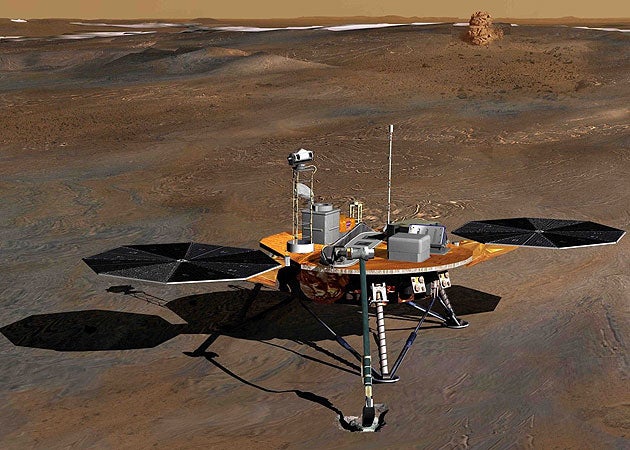Nasa's Phoenix Lander 'tastes and touches' water on Mars

NASA has confirmed that the Phoenix Mars Lander has identified one of the crucial ingredients for life in a soil sample.
"We have water," said William Boynton of the University of Arizona, one of the lead scientists monitoring the mission. "We've now finally touched it and tasted it. From my standpoint, it tastes very fine."
Scientists popped open champagne when they received confirmation that the soil contained ice. Until now, evidence of ice in Mars's north pole region has been largely circumstantial.
The Phoenix Lander's robotic arm found the sample on Wednesday and confirmed its composition through tests of the vapours created when it was heated in an oven.
Dr Boynton said he had described the news as the mission's "Wicked Witch" moment, from the film The Wizard of Oz in which the Wicked Witch exclaims "I'm melting, melting."
The news arrived late last night from the Red Planet, which, depending on it and the Earth's orbits, can be between 33 million and 249 million miles away.
Because of this discovery, the space agency has extended Phoenix's mission and it will receive extra funding to investigate the planet's surface until the end of September, five weeks more than originally planned. Peter Smith, Phoenix's principal investigator, said: "Mars is giving us some surprises. One is how the soil is behaving. The ice-rich layers stick to the scoop when poised in the sun ... That has presented challenges."
The successful scoop came from a two-inch trench and followed two failed attempts. Researchers were able to prove the soil had ice in it after it melted in the oven at 0C (32 degrees Fahrenheit) and released water molecules. The next move is to bake the soil to sniff for carbon-based compounds, which could suggest the presence of basic elements of biology.
Since landing on 25 May, Phoenix has been studying the soil with instruments that include a microscope, chemistry lab, camera and a conductivity probe. It is conducting experiments to learn whether the ice ever melted in the Red Planet's history, and whether that could have led to a more hospitable environment.
Although led by the University of Arizona and managed from Nasa's Jet Propulsion Laboratory in Pasadena, California, the mission has seen contributions from across the world, including Canada, Switzerland, Denmark, Germany and Finland.
The latest scientific finding is the first piece of good news for a mission that has been dogged by difficulties in recent weeks. Scientists had waited with bated breath to learn if their probe's braking system was working and the vessel had landed safely. However, an electrical short circuit on one of Phoenix's eight test ovens threatened to destroy the instrument but scientists said the problem had not recurred.
The Lander, which has spent several weeks drilling into the ice, also had trouble getting the ice shavings into the oven. The Lander has taken 400 pictures to form a colour panorama of the planet's surface and beamed them back to the project's HQ. Mark Lemmon of Texas A&M University said the process of stitching them together was "painstaking" but showed a Martian surface studded with rocks and under a shroud of dust. "Essentially it's an ice-dominated terrain," he said.
Photos taken by the Mars Global surveyor in 2001 and 2005 showed gullies in the side of a crater, seemingly caused by water bursting out the crater wall. In 2002, the orbiting Odyssey spacecraft spied what looked like a reservoir of buried ice. After Phoenix arrived, it found what looked like ice in a hard patch underneath its landing site and changes in a trench indicated some ice had turned to gas when exposed to the sun.
In 2006, Nasa viewed evidence of water moving across the planet's surface.
The extension to the mission in the wake of this success will add $2m (£1m) to the current $420m cost.
Phoenix is not the only human presence on Mars at the moment. But unlike the two rovers working near the Martian equator, Phoenix's lifetime cannot be extended much further because it is unlikely to have enough power left to survive the planet's winter.
Join our commenting forum
Join thought-provoking conversations, follow other Independent readers and see their replies
Comments